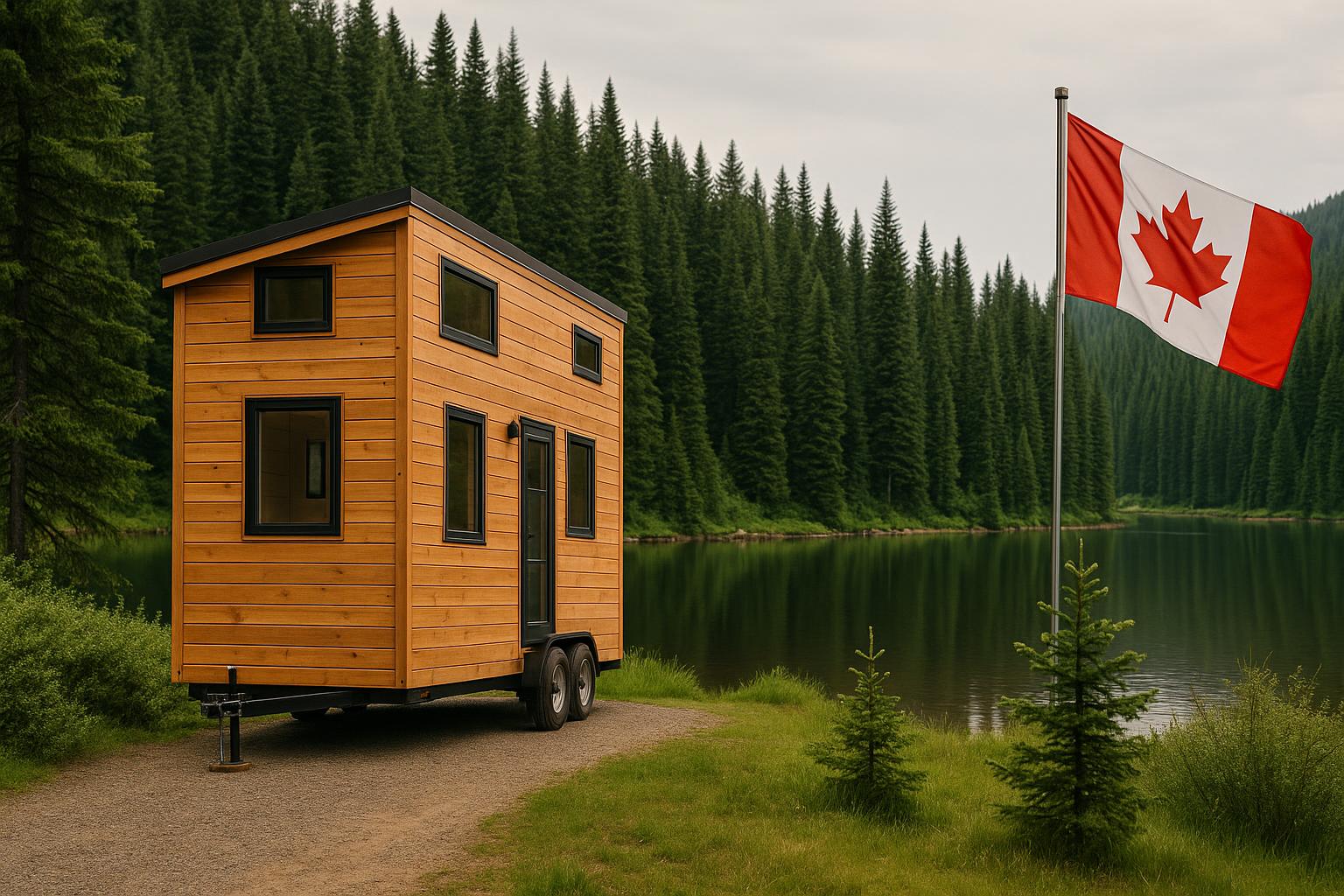
How to Build a Lucrative Tiny Home Rental Business in Canada: The 2025 Guide
Estimated reading time: 7 minutes
Key Takeaways
- Market Potential: Tiny home rentals are booming with rising demand from diverse demographics.
- Regulatory Preparedness: Understanding zoning, permits, and local regulations is crucial.
- Effective Management: Robust property management and automation can maximize occupancy and revenue.
- Sustainability & Ethics: Eco-friendly practices and community engagement enhance credibility.
Table of contents
- Introduction: Tiny Home Rental Business Canada in 2025
- Understanding the Tiny Home Rental Market in Canada
- Getting Started: Licensing and Regulatory Requirements
- Property Management Essentials for Tiny Home Rentals
- Scaling Your Tiny Home Rental Business in Canada
- Ethical Considerations and Sustainable Practices
- Final Thoughts: Roadmap to Success
- Frequently Asked Questions
Introduction: Tiny Home Rental Business Canada in 2025
Starting a tiny home rental business in Canada is now a leading opportunity for Canadian entrepreneurs. As we step into 2025, demand for tiny home rentals is soaring. Canadians are looking for alternative living options that are affordable, eco-friendly, and flexible. This rising consumer interest is fuelled by:
- *High rental yields for owners*
- *Lower environmental footprints compared to traditional homes*
- *Growing appeal among millennials, retirees, and digital nomads*
These factors create a strong business case for tiny home rentals. The Canadian tiny homes market is set to exceed USD $432 billion by 2032, as more tenants seek both unique short-term getaways and long-term housing options. For further insight, check out the
market research report and
industry trends analysis.
In this comprehensive 2025 guide, you’ll learn everything you need to know about launching and scaling a tiny home rental business in Canada. From understanding industry trends to mastering regulations, property management, and sustainable growth, this post will walk you through each step.
Understanding the Tiny Home Rental Market in Canada: Tiny Home Rentals and Industry Trends
Tiny homes are small, highly efficient living spaces. They offer flexibility, smart storage, and a lower carbon footprint. These characteristics make tiny home rentals a preferred choice for a growing number of Canadians.
Key Features of Tiny Home Rentals
- *Typically between 100 and 400 square feet*
- *Often built with sustainable materials*
- *Movable or permanent, placed on private or leased land*
- *Customizable with modern amenities for a unique experience*
Market Growth and Demand
The Canadian tiny home rentals market is forecast to grow by 3.88% annually from 2025 through 2032. This growth is driven by several factors:
- Affordability: Traditional home prices have surged, making tiny home rentals an attractive alternative.
- Sustainability: Canadians are seeking greener living solutions, pushing up demand for eco-friendly design.
- Remote Work and Travel: More people, especially digital nomads, want flexible housing options.
- Short-Term Rental (STR) Boom: STR listings, including tiny homes, have grown significantly in many regions. For more details, read the
Statistics Canada report.
Challenges and Opportunities for Canadian Entrepreneurs
Opportunities:
- Tourist Hotspots: High demand in scenic and recreational areas of Canada.
- Rural Expansion: Underserviced regions provide room for market entry.
- Lifestyle Changes: An increase in retirees and young professionals seeking unique, minimalistic living.
Challenges:
- Regulatory Complexity: Zoning, land use, and safety standards vary by region.
- Competition: Growing interest from both individual and institutional investors.
- Seasonal Demand Variability: Some regions experience significant fluctuations between high and low seasons.
Understanding these market dynamics helps Canadian entrepreneurs spot the most promising locations, avoid regulatory pitfalls, and design resilient business models.
Getting Started: Licensing and Regulatory Requirements for Tiny Home Rentals
Legal and regulatory compliance is the first step in launching a successful tiny home rental business in Canada. Each province, territory, and municipality has its own rules. Overlooking these details can result in costly delays or even shutdowns.
Essential Steps
-
Secure Your Business License
Register your business with local and provincial authorities, and with the Canada Revenue Agency (CRA) for tax purposes.
-
Local Zoning and Land-Use By-Laws
Research whether tiny homes and short-term rentals are permitted in your target area. Some municipalities ban or restrict these rentals, so consult your local government before investing.
-
Construction and Occupancy Permits
Obtain building permits before starting construction and ensure compliance with local codes regarding size, safety, accessibility, and energy efficiency. Secure occupancy permits after passing inspections.
-
Health, Safety, and Accessibility Standards
Meet fire safety regulations by installing smoke alarms and ensuring proper egress. Verify that water, sanitation, and ventilation systems comply with local standards, and design with accessibility in mind.
-
Ethical and Community Considerations
Build positive community relations by respecting local norms such as noise limits, parking regulations, and neighborhood character. Operate transparently to avoid negative impacts on local housing affordability.
Addressing these requirements is vital for the credibility and sustainability of your tiny home rental business. For additional guidance, review the
Statistics Canada guidelines and
legal requirements overview.
Property Management Essentials for Tiny Home Rentals
Maintaining Cleanliness and Safety
- *Conduct regular, deep cleaning after each guest stay*
- *Proactively inspect and repair plumbing, heating, and built-in furniture*
- *Prioritize routine safety checks including alarms, lock systems, and emergency exits*
Effective Tenant Management
- Guest Vetting: Use screening processes to select reliable tenants, especially for short-term stays.
- Clear Communication: Provide straightforward guides, check-in/out instructions, and local tips.
- Support: Offer rapid responses to inquiries or concerns, ideally within a few hours.
Optimizing the Guest Experience
- *Offer thoughtful amenities such as Wi-Fi, kitchenette, and eco-friendly toiletries*
- *Include personal touches like welcome baskets or local information booklets*
- *Utilize property management software to streamline bookings and finances*
Leverage Technology
Digital tools can greatly enhance property management. Consider using smart lock systems and thermostats to improve security and energy efficiency. For more tech solutions, explore
smart home technology.
Scaling Your Tiny Home Rental Business in Canada: Growing and Automating Your Portfolio
Strategies for Scaling
-
Automate with Property Management Systems (PMS):
A PMS can help manage multiple units’ bookings, guest communication, and maintenance scheduling, while also tracking finances.
-
Outsource for Efficiency:
Hire professional cleaning and maintenance services, or consider third-party property managers if your operations expand across different locations.
-
Strategic Partnerships:
Form partnerships for land access or join co-hosting programs, and explore collaborations with local tourism associations.
-
Financial Planning and Reinvestment:
Create a detailed financial plan that includes forecasts for capital expenditure and operational costs. Reinvest profits into expansion and upgrades while balancing cash flow.
-
Adapt to Market Fluctuations:
Adjust pricing and marketing strategies to reflect seasonal variability and local events. Analyze occupancy rates and guest feedback to refine your approach.
Streamlining core tasks with automation and smart management can help you transition from a single unit to a multi-unit operation. For further insights, visit the
CMHC mid-year update.
Ethical Considerations and Sustainable Practices for Tiny Home Rentals
Employ Eco-Friendly Solutions
- *Build with recycled or renewable materials such as reclaimed lumber, steel, or bamboo*
- *Install solar panels, energy-efficient lighting, and water conservation fixtures*
- *Consider innovative solutions like composting toilets or greywater systems. Learn more
here*
Minimize Land and Ecological Impact
- *Position homes to minimize ecological disruption and avoid sensitive areas*
- *Preserve existing vegetation and implement responsible landscaping. Get ideas
here*
Fair and Transparent Operations
- *Offer fair pricing without displacing local renters*
- *Implement inclusive tenant policies and maintain transparent operations*
Community Engagement
- *Partner with local organizations to support community needs*
- *Engage with neighbours and, where possible, hire locally for support roles*
Adopting sustainable and ethical practices not only builds community trust but also future-proofs your business. For additional resources, check out the
industry reports.
Final Thoughts: Roadmap to Success for Canadian Entrepreneurs in 2025
Canada’s tiny home rental market is set for remarkable growth in 2025 and beyond. To thrive, Canadian entrepreneurs should focus on mastering legal requirements, building robust property management systems, and strategically scaling their operations while maintaining ethical and sustainable practices.
Clear communication, careful planning, and ongoing market awareness are key to long-term success. As demand for innovative, flexible, and eco-friendly living solutions increases, your well-run tiny home business can lead in both profitability and community impact.
Ready to take the next step? Dive into Canada’s booming market and build your venture for a sustainable, successful future. For further insights, refer to the
market research and the
CMHC update.
Frequently Asked Questions
Q1: What makes tiny home rentals a unique business opportunity in Canada?
A1: Tiny home rentals offer a blend of affordability, sustainability, and flexibility. They cater to diverse groups—from millennials to retirees—seeking innovative living solutions, making them a lucrative niche in today’s market.
Q2: What are the key regulatory challenges for launching a tiny home rental business?
A2: The challenges include navigating local zoning laws, obtaining necessary permits for construction and occupancy, and ensuring compliance with health and safety standards. It’s essential to consult local authorities to avoid costly setbacks.
Q3: How can property owners scale their tiny home rental business effectively?
A3: Scaling can be achieved through automation with property management systems, outsourcing maintenance and cleaning services, and forming strategic local partnerships. Continuous financial planning and reinvestment are also key to sustainable growth.

Leave a Reply